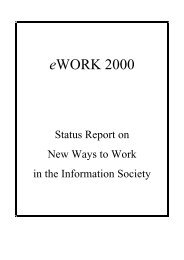Proceedings of 8th European Assembly on telework (Telework2001)
Proceedings of 8th European Assembly on telework (Telework2001)
Proceedings of 8th European Assembly on telework (Telework2001)
Create successful ePaper yourself
Turn your PDF publications into a flip-book with our unique Google optimized e-Paper software.
106Siemens case: Knowledge sharing by vide<strong>on</strong>egotiati<strong>on</strong>Pasi Rajander, Siemens Companies, FinlandPrefaceThe objective <str<strong>on</strong>g>of</str<strong>on</strong>g> the PC-Video project carried out by Siemens Osakeyhtiö in Finland was toc<strong>on</strong>duct a feasibility study <str<strong>on</strong>g>of</str<strong>on</strong>g> how video negotiati<strong>on</strong> and pc-video negotiati<strong>on</strong> equipment could beused in the realizati<strong>on</strong> <str<strong>on</strong>g>of</str<strong>on</strong>g> <strong>telework</strong> and e-learning. In the following, I shall cover the findings <str<strong>on</strong>g>of</str<strong>on</strong>g> thisproject.Over 50% <str<strong>on</strong>g>of</str<strong>on</strong>g> the pers<strong>on</strong>nel <str<strong>on</strong>g>of</str<strong>on</strong>g> Siemens Osakeyhtiö have a <strong>telework</strong> c<strong>on</strong>tract <str<strong>on</strong>g>of</str<strong>on</strong>g> employment in force.Corporate business is divided into different business units and it is carried out in different places <str<strong>on</strong>g>of</str<strong>on</strong>g>business and subsidiaries in Finland and in the Baltic countries. The multinati<strong>on</strong>al organisati<strong>on</strong>alstructure presents a challenge for the flow <str<strong>on</strong>g>of</str<strong>on</strong>g> informati<strong>on</strong> both within the organisati<strong>on</strong> itself and inrelati<strong>on</strong> to its customers.Despite the technical background, the focus is <strong>on</strong> assessing work structures and the cooperati<strong>on</strong> <str<strong>on</strong>g>of</str<strong>on</strong>g>people, as well as surveying future possibilities.From Telework to e-WorkIn this c<strong>on</strong>text, <strong>telework</strong> is understood in its broadest sense. C<strong>on</strong>sequently, a more appropriate termfor what by traditi<strong>on</strong> has been called <strong>telework</strong> would be e-work. The changes that have taken placeregarding work and work structures have affected companies and their employees both in terms <str<strong>on</strong>g>of</str<strong>on</strong>g>the global market and globalisati<strong>on</strong> and mobility <strong>on</strong> a pers<strong>on</strong>al level, which has allowed work tobecome less tied to a specific time and place.When we talk about e-work, we talk about how to utilize new technology. However, it is <strong>on</strong>ly <strong>on</strong>easpect. Changing technology also changes the operati<strong>on</strong>al work, as well as the processes and themodes <str<strong>on</strong>g>of</str<strong>on</strong>g> acti<strong>on</strong>. When we think about e-work, words like networking, knowledge management,knowledge sharing, flexibility and mobility are the key words. One <str<strong>on</strong>g>of</str<strong>on</strong>g> the most important issues ishow to gain access to informati<strong>on</strong> regardless <str<strong>on</strong>g>of</str<strong>on</strong>g> time and place.








